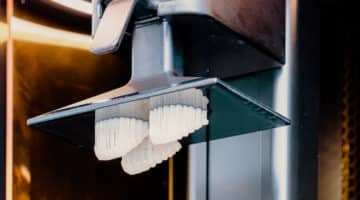Of the many digital dental tools available, one stands out due to its significant transformative abilities: the intraoral scanner. The intraoral scanner gives you unmatched access to even the hardest-to-reach areas and kicks off even the most complex of cases. By now over 50% of all US practices have at least one intraoral scanner—though one per operatory is becoming the new normal.
Scanners have enabled dentists to instantly diagnose during examinations and treatment planning sessions. While the 3D models they create do wonders for restorative visualization, wellness scans are an incredible diagnostic tool and some scanners are offering caries detection.
What is caries detection?
Caries (dental cavities) are areas of damage to the teeth’s structure caused by acids produced by bacteria in the mouth. When you eat certain foods, the bacteria on your teeth break them down and produce acids. They (the bacteria) digest the sugars left over from food in the mouth, converting them into acids as a waste product.
These caries can be detected using several diagnostic tools and techniques. The teeth are observed to note changes or deficiencies in the enamel, dentine, and cementum to detect any signs of demineralization or damage caused by caries.
How was caries detection traditionally done?
Initially, dentists visually examined the teeth’s surface using dental mirrors and bright lighting. They looked for visual changes in the dental structure and any signs of tooth decay, such as discoloration, white spots, brown or black spots, increased opacity and roughness of the enamel, or visible holes (cavities).
Currently, tactile examination, where dental probes are used to gently feel the surfaces of the teeth to assess the texture of the enamel and look for soft, sticky areas, is used by dentists to detect caries.
There are several other methods in play used to detect caries:
- Laser fluorescence and near-infrared detection
- Dyes
- Radiographic imaging
- The tooth separation method is used to examine any suspicious area on the approximal surface.
By combining these different methods, dentists could effectively—though painstakingly—detect caries and assess their severity, creating optimal room for appropriate treatment and preventive measures.
How intraoral scanners now use caries detection
Through high-resolution imaging, intraoral scanners capture detailed images of dental structures. They can be used to visualize enamel surfaces and potential carious lesions, including early signs of caries, producing clear and precise images that enable dentists to visualize even minor changes in tooth structure.
Some intraoral scanners have software algorithms capable of mapping tooth surfaces and detecting abnormalities. By analyzing the scanned images, they can identify areas of demineralization or enamel degradation indicative of carious lesions.
What intraoral scanners have caries detection
Today, there are a few intraoral scanners with dedicated caries detection capabilities. We have the:
3Shape TRIOS 4 and 5
3Shape TRIOS 4 and 5 intraoral scanners have built-in fluorescent technology that aids in the identification of possible caries. Using these scanners, dentists can detect surface caries in real-time without needing an additional scanning device.
They also make patient monitoring easier, as dentists can compare scans over time to access preventive insights, which is important for optimal patient comfort. Get a free 3Shape TRIOS when you work with Dandy.
iTero
Some iTero scanners use Near Infrared Imaging (NIRI), a technology that employs near-infrared light in dentistry to detect caries. With one scan, multiple layers of data can be viewed: a 3D model and 2D color images mapped to the 3D model.
You can review the corresponding color and NIRI images to gather a comprehensive view of the situation while building a complete model of the teeth.
Planmeca
Planmeca intraoral scanners can be used during dental examination procedures to spot cracks and fractures in the patient’s teeth. They are light and ergonomic, with a dual button that lets dentists operate hand-free or control at their fingertips. The scanning tip uses transillumination technology for caries detection.
Advantages of intraoral scanner offering caries detection
Intraoral scanners with caries detection create a streamlined workflow for dentists, and a more accurate and personalized treatment plan, improving patient outcomes and satisfaction.
Dentists interested in adopting intraoral scanners with caries detection capabilities may consider the need for one of the above mentioned scanners and weigh its price and benefits against the learning curve and ease of your current caries detection techniques.



